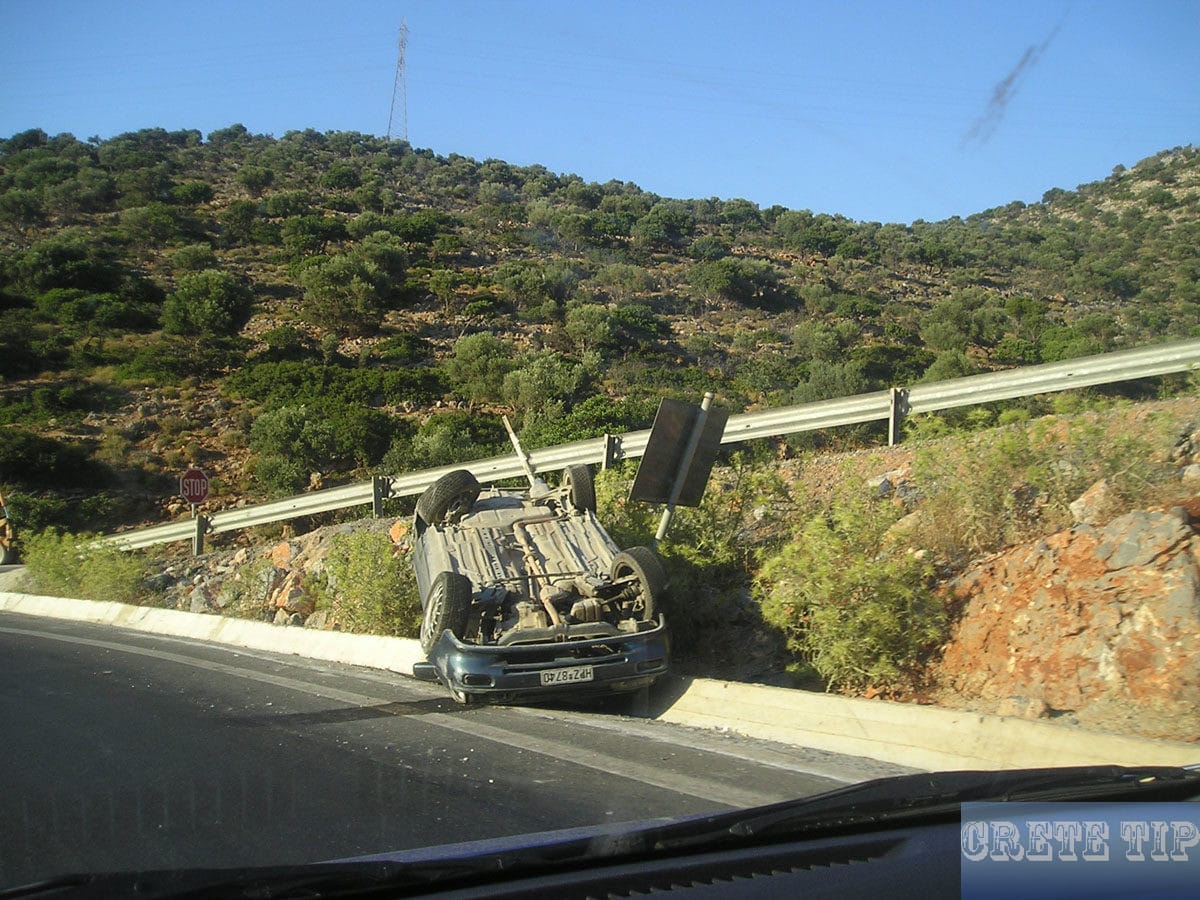Greek road accident statistics for 2023 and the dramatic increase in fatalities on Crete last year.

Road accidents in Greece in 2023
In 2023, the number of road traffic incidents in Greece reached 10,553, marking a slight rise of 0.6% compared to the previous year, which had 10,487 incidents. These occurrences resulted in injuries or fatalities to individuals.
The total number of victims from these road incidents rose by 1.4%, with 13,461 individuals affected in 2023, compared to 13,279 in 2022.
According to data released by the relevant statistical authority, there were 646 reported fatalities, showing a decrease of 1.2%.
Additionally, there were 659 individuals with severe injuries, a decline of 0.8%, alongside 12,156 light injuries, which saw an increase of 1.6%.
Among the 646 deceased, a significant portion consisted of drivers, accounting for 72.6%. Passengers comprised 11.6%, while pedestrians made up 15.8% of the fatalities.
There was a notable gender imbalance, with 82% of those killed being men and 18% women.
Age Distribution
The distribution of deaths was significant across different age groups:
- 0-24 years: 17.8%
- 25-49 years: 30%
- 50-64 years: 21.7%
- 65 years and over: 28.8%
It was noted that the highest percentage of fatalities among drivers occurred in the 25-49 years age group, at 33.9%.
For passengers, the 0-24 years age group had the largest share at 33.3%, whereas for pedestrians, the most affected were those aged 65 and above, comprising 55.9%.
Vehicle Type Involvement
The analysis of fatalities by vehicle type revealed that 245 individuals (or 37.9%) were in passenger cars, while 250 (or 38.7%) were on two-wheel vehicles, including motorcycles. Pedestrians constituted 15.8% of the fatalities.
Location of Incidents
Examining the locations of these accidents provided insights into their nature:
- In urban areas, 26.1% of fatalities involved passengers, while 46% involved riders on two-wheel vehicles.
- In rural areas, the percentages were 48.6% for passenger vehicles and 32.6% for two-wheel vehicles.
- On motorways, the figures shifted dramatically, with 69.7% of deaths being associated with passenger cars and only 15.2% with two-wheel vehicles.
Accident Rate and Regional Disparities
The accident rate for the nation was calculated at 1,013.3 incidents per 1,000,000 inhabitants.
The rankings revealed that the Attica Region held the highest rate, with 1,474.9 incidents. This was followed by the Sterea Ellada Region at 1,194.6 incidents, and the Central Macedonia Region with 1,160.1 incidents.
The index of deaths per 1,000,000 inhabitants stood at 62 for the entire country.
The Southern Aegean Region had the highest fatality rate at 119.3 per 1,000,000 inhabitants, highlighting regional variations in road safety.
Compensation and Liabilities
In incidents involving road traffic accidents, victims or families of those killed often seek compensation. The compensatory framework falls under civil liability laws, which dictate how damages can be claimed.
The relevant laws outline that victims can pursue compensation for medical costs, loss of income, and emotional distress arising from the accident.
In cases where negligence is clear, the party at fault bears responsibility for these claims.
This notion of liability is often scrutinised in court proceedings or during settlement negotiations.
Negotiated settlements are common in road traffic cases, providing an avenue for both parties to resolve disputes amicably without proceeding to trial.
This approach is frequently seen in private insurance claims where both insurers can engage in discussions.
Traffic Monitoring and Safety Measures
To enhance road safety, continuous monitoring of traffic patterns is essential.
Authorities focus on identifying causes of accidents, which include speeding, driving under the influence, and distracted driving.
Efforts are ongoing to raise public awareness and implement measures that mitigate risks associated with these behaviours.
Moreover, the enforcement of traffic regulations plays a significant role in reducing incidents.
Measures such as speed limit enforcement, seat belt use campaigns, and promoting safe driving habits are critical strategies aimed at curbing road traffic accidents.
Legislative Framework
The legal framework surrounding traffic accidents encompasses various regulations and procedures that govern how incidents are handled.
Legal precedents play a significant role in establishing guidelines for liability and compensation within the context of road traffic incidents.
Court rulings contribute to shaping the norms of accountability and restitution for victims.
This jurisprudence helps clarify the circumstances under which individuals or entities can be held liable for damages caused in traffic accidents.
Practicals Issues in Traffic Accidents
There are practical issues that arise during the aftermath of traffic incidents.
These can include logistics concerning vehicle recovery and repair, coordination with insurance providers, and the documentation of damages incurred.
Victims often need to navigate the complexities of claiming compensation while dealing with the emotional distress stemming from the accident. Understanding their rights and the relevant legal avenues available to them is crucial for effective resolution.
65% more road deaths on Crete

There has been a shocking 65% rise in road traffic fatalities in Crete, yet it remains largely unaddressed in public discussions.
While the national average for increased road deaths stands at around 4.5%, the statistics from Crete present a much more alarming picture.
According to provisional figures from the nationwide association “SOS Road Crimes,” a total of 665 individuals lost their lives to road accidents in Greece in 2024, up from 637 in 2023.
In Crete specifically, 64 people died on the roads in 2024, a significant increase from 32 fatalities the previous year.
These figures do not account for serious injuries, which amounted to 37 in 2023, alongside 142 minor injuries that same year.
The president of the association, George Kouvidis, has highlighted some troubling trends: toxicology tests indicated that in 17 fatal cases, either alcohol or drugs were detected in the deceased’s systems.
Limited Effectiveness of the New Traffic Code
Despite the introduction of a revised traffic code, which ostensibly seeks to tighten regulations and increase penalties, the focus has been heavily skewed towards adjusting fines rather than effectively addressing the core issues leading to these tragic accidents.
Kouvidis pointed out that while several European nations have set zero tolerance for alcohol consumption while driving, Greece stubbornly maintains a limit of 0.5 grams.
A ministerial decree could easily adjust this legal alcohol limit to zero, yet this has not materialised.
The president emphasised the dire need for a genuine discussion surrounding road safety in Crete. He stated, “The issue of road accidents—especially in Crete—is not being discussed at all. We want to instigate a dialogue.”
The current traffic code does not adequately tackle the main causes of traffic collisions, such as speeding, alcohol, drug use, distraction, and hit-and-run incidents.
For instance, the regulation regarding a 30 km/h speed limit in residential areas has received little attention. There has been no change relating to alcohol and drug consumption, nor any provisions made to address accidents caused by mobile phone use.
Proposed Changes Needed
The call for more effective measures includes addressing the following categories:
-
Alcohol Consumption: Many advocate for a stricter limit or complete ban on alcohol for drivers, aligning Greece with five other European nations that have initiated zero tolerance policies. This would place public safety at a higher priority.
-
Drug Usage: The threshold for legal drug use while driving also needs reevaluation, as drug-related incidents have seen an uptick.
-
Distraction Measures: Heightened penalties for accidents caused by distractions, such as mobile phone use, are essential to reduce incidents significantly.
-
Pedestrian Safety: More careful planning should be given to areas with high foot traffic to ensure pedestrian safety, particularly in urban centres.
Public Safety and Community Responsibility
Considering the gravity of the situation, both government officials and the community must focus on bolstering road safety measures.
With a stark rise in fatalities, many residents feel it is vital for local authorities to take this issue seriously and implement effective strategies.
As Kouvidis noted, “It is not merely about imposing fines; it is about safeguarding lives.”
The increase in fatalities highlights the pressing need for comprehensive measures that address all aspects of road safety.
The community is encouraged to participate in discussions and advocate for change, understanding that each individual’s action can contribute to overall public safety.
The responses to these statistics should not only focus on punitive measures but should also foster awareness and education regarding traffic regulations and their implications on everyday life.
Initiatives such as campaigns in schools, public workshops, and increased enforcement of existing laws can help shift the narrative toward preventive care and safety awareness.
By actively engaging in discussions and pushing for substantial changes, Crete can aim to reverse the shocking trends in road fatalities and work towards a safer environment for everyone on the road.
The call for reform continues to resonate with those deeply affected by road accidents, who analyse these changes for a chance to promote safety and awareness in local communities.




